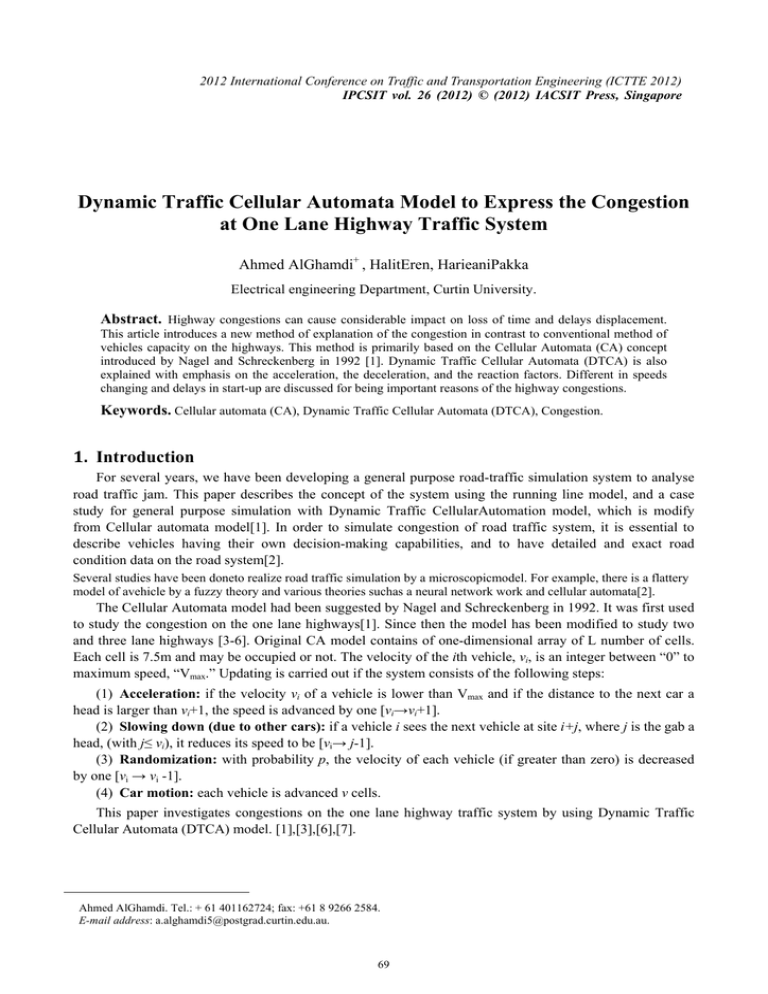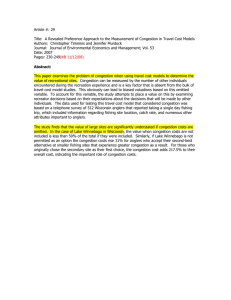Dynamic Traffic Cellular Automata Model to Express the Congestion Ahmed AlGhamdi
advertisement

2012 International Conference on Traffic and Transportation Engineering (ICTTE 2012) IPCSIT vol. 26 (2012) © (2012) IACSIT Press, Singapore Dynamic Traffic Cellular Automata Model to Express the Congestion at One Lane Highway Traffic System Ahmed AlGhamdi+ , HalitEren, HarieaniPakka Electrical engineering Department, Curtin University. Abstract. Highway congestions can cause considerable impact on loss of time and delays displacement. This article introduces a new method of explanation of the congestion in contrast to conventional method of vehicles capacity on the highways. This method is primarily based on the Cellular Automata (CA) concept introduced by Nagel and Schreckenberg in 1992 [1]. Dynamic Traffic Cellular Automata (DTCA) is also explained with emphasis on the acceleration, the deceleration, and the reaction factors. Different in speeds changing and delays in start-up are discussed for being important reasons of the highway congestions. Keywords. Cellular automata (CA), Dynamic Traffic Cellular Automata (DTCA), Congestion. 1. Introduction For several years, we have been developing a general purpose road-traffic simulation system to analyse road traffic jam. This paper describes the concept of the system using the running line model, and a case study for general purpose simulation with Dynamic Traffic CellularAutomation model, which is modify from Cellular automata model[1]. In order to simulate congestion of road traffic system, it is essential to describe vehicles having their own decision-making capabilities, and to have detailed and exact road condition data on the road system[2]. Several studies have been doneto realize road traffic simulation by a microscopicmodel. For example, there is a flattery model of avehicle by a fuzzy theory and various theories suchas a neural network work and cellular automata[2]. The Cellular Automata model had been suggested by Nagel and Schreckenberg in 1992. It was first used to study the congestion on the one lane highways[1]. Since then the model has been modified to study two and three lane highways [3-6]. Original CA model contains of one-dimensional array of L number of cells. Each cell is 7.5m and may be occupied or not. The velocity of the ith vehicle, vi, is an integer between “0” to maximum speed, “Vmax.” Updating is carried out if the system consists of the following steps: (1) Acceleration: if the velocity vi of a vehicle is lower than Vmax and if the distance to the next car a head is larger than vi+1, the speed is advanced by one [vi→vi+1]. (2) Slowing down (due to other cars): if a vehicle i sees the next vehicle at site i+j, where j is the gab a head, (with j≤ νi), it reduces its speed to be [vi→ j-1]. (3) Randomization: with probability р, the velocity of each vehicle (if greater than zero) is decreased by one [vi → vi -1]. (4) Car motion: each vehicle is advanced ν cells. This paper investigates congestions on the one lane highway traffic system by using Dynamic Traffic Cellular Automata (DTCA) model. [1],[3],[6],[7]. Ahmed AlGhamdi. Tel.: + 61 401162724; fax: +61 8 9266 2584. E-mail address: a.alghamdi5@postgrad.curtin.edu.au. 69 In this article a brief explanation about Cellular Automata (CA) has been given in the introduction. The follow part provides the details about A Dynamic Traffic Cellular Automata (DTCA), and final part clarifies the new concept on congestion. In this article there are two reasons that create the congestion. 2. Dynamic Traffic Cellular Automata (DTCA) A Dynamic Traffic Cellular Automata (DTCA) that has been suggested in this paper can be compared with the original CA model. Basically it offers three main differences: 1) In the CA the road is divided into equal length cells, each cell being 7.5 m. A cell may or may not be occupied. The CA model assumes that a vehicle is restricted by fixed position, while the position of the vehicle in the DTCA is not limited with fixed cells on the highway. However, the vehicle in the MCA is viewed as a cell 7.5 m moving through the highway. 2) Nagel and Schreckenberg [1] used fix amount of acceleration and declaration, equal to 1 cell (±7.5 m/s2). According to Bansal and Brar maximum deceleration is explained in Equation 1. decmax = G (r cosθ v + sin θ v ) (1) Where G is the gravity (9.81m/s2), r is friction coefficient for dry seal roads (0.6) and θv is vehicle angle of inclination of the plane of the horizontal. It is assumed that ε equal to “0”. This equation indicates that declaration cannot be greater than 5.886 m/s2 while in Nagel and Schreckenberg model assumes 7.5 m/s2, cell length, at all times [8].different decelerations are achieved by different driver habits, road and traffic condtiones. These diffrences are stated by deceleration factor (β). β gives the proportionof the decmax, and it will be 0≤β≤1. dec = dec max × β (2) Similarly, the maximum acceleration (accmax) is 4.905 m/s2, which is equal to 17.658 km/hr2. Maximum acceleration leads moving the vehicle from zero to 17.658 km/hr speed in first second. In six second with maximum acceleration the vehicle can approach 106 km/hr, which is reasonable for most vehicles. However, different accelerations are achieved by different driver habits, road and traffic condtiones. These diffrences are stated by acceleration factor (α). α gives the proportionof the accmax. for example α is equal 1then acc will equal to accmax, and it will be 0≤α≤1. acc = acc max × α (3) 3) The original CA uses one randomazation factor (p) while MCA uses three independent randomazation factors (α, β and pd). α is acceleration facor, β is decleration factor and p is driver reaction factor. Those factore describe the driving satuation on highways. α and β are very issential to mange of zero or no movment. xi-1 Vi-1 xi xrel(i-1,i)=min(3.Vi-1) Vi xi+1 xrel(i,i+1)=min(3.Vi) Vi+1 Fig. 1: Relation between the Velocity and the Gabs between the Vehicles on the highway • Changes in speed due to acceleration if vi ,n < Vmax & ϕ ⋅ xrel (i, i + 1) > vi ,n (4) then vi ,n +1 = vi ,n + T ⋅ acc Where i is a cell number n the sequence number T is the fixed time and we assume it equal to “1” second φ is safety factor • Deceleration 70 if vi ,n ≤ ϕ ⋅ xrel (i, i + 1) then vi ,n+1 = max(vi ,n − T ⋅ decmax or ϕ ⋅ xrel (i, i + 1) / T ) • Randomization if vi ,n > 0 with probability β (6) then vi ,n+1 = vi ,n − T ⋅ dec • Car motion xi ,n +1 = xi ,n + T ⋅ vi ,n 2.1 (5) (7) Simulation We consider kcars moving on a strait road, with no inclination, perfect weather and road conditions. The boundary condition adopted in this work is periodic. Since real traffic data can be well described by the parameters Vmax = 110 km/h or 30.6 m/s, p = 0.5 and α and β=N(0.4, 0.2). We assume these parameters in our implementation. The length of the evolution time is 2000s. 3. Congestion Best way to observe the congestion is looking at the: decs (t ) = acc d (t ) − acc (t ) (8) Where decs is deceleration strength, accd is acceleration to desired velocity decs(t ) = dv d (t ) dv(t ) − dt dt (9) Where Vd (t ) ≈ Vmax decs (t ) = 0 − dv (t ) dt (10) Fig. 2: congestion loos From the Figure (2) the black curve shows decs (t ) . There are two things could get it from decs (t ) curve: 1) the limits of congestion (where the congestion starts and where it finishes). 2) Observing who the strength of congestion is and when that happened. Another factor needs to notice is losing (LOSS) te LOSS = ∫ Vd − v (t ) dt (11) t0 71 Where t0 is the time starting congestion and we will assume it as 0, and teis the time of finishing of congestion. While Vd ≈ Vmax te LOSS = ∫ Vmax − v(t ) dt (12) LOSS = Vmax − ( x(te ) − x(t0 )) (13) 0 LOSS = vmax − x(te ) (14) Figure (3) illustrates the overview of traffic system in the simulation. It shows the shape and behaviour of congestion in time on the highway. The global observation of the congestion lets us to investigate the reasons why congestions take place and how they are dispersed. In this figure the movement of vehicle on the highway can be recognized by time and the position at the road. From Figure (3A), it can be observed that the vehicle (1), (Bolded), movement during the experiment and it can be recognized the movement through the congestion. Focusing on just small part of Figure (3A) to be appear in Figure (3B), which helps to understand the cluster of vehicles and how each of them can impacts on the next one, also by spotlight on one vehicle and how is it moving with the cluster to understand the reasons of creating of congestions, as well as peaking in demand and a bottleneck regarding to peter [9]. Figures (3 A&B) expressing the essential reasons of congestion, which are speed conflict and delay of start-up movement. Fig.2: A: congested Highway, B: congested High way foucusing on the congestion Referring to Figure (2) shows the vehicle (1), in the Figure 3A, movement in two scenarios: 1) during the congestion and 2) during freeway. From the Figure (2), it can be seen the position difference. Congestion in this figure can be explained as time and position delay comparison to desired position at the same time. The gap between the curves of congested and desired vehicles is expanding from starting the congestion to be end. It is also can be observed the strength of congestion for individual vehicle and it is losing. 4. Conclusion In this article, Dynamic Traffic Cellular Automata has been discussed cooperation with Nagel and Schreckenberg CA model.Finding the time and distance loss equation as result of compression between congested and free highways.Defined acceleration and deceleration factors respectively. 72 5. Referencing [1] K. Nagel and M. Schreckenberg, "A cellular automaton model for freeway traffic," Journal de Physique I, vol. 2, pp. 2221-2229, 1992. [2] M. Namekawa, et al., "General purpose road traffic simulation system with a cell automaton model," Melbourne, VIC, Australia, 2005, pp. 3002-3008. [3] K. Rickert, et al., "Two lane traffic simulation using cellular automata," Physica A, vol. 231, pp. 534-550, 1996. [4] A. Awazu, "Dynamics of two equivalent lanes traffic flow model: self orgnization of the slow lane and fast lane," Journal of Physical Society of Japn vol. 64, pp. 1071-1074, 1998. [5] K. Rawat, et al., "Two-lane traffic flow simulation model via cellular automaton," International Journal of vehicular technology, vol. 2012, 2012. [6] A. Daoudia and N. Moussa, "Numerical simulations of three-lane traffic model using celluler automata," Chinese journal of physics, vol. 41, pp. 671-681, 2003. [7] L. Ke-Ping, "Car deceleration considering its own velocity in cellular automata model," Commun. Theor. Phys., vol. 45, pp. 113-116, 2006. [8] R. K. Bansal and J. S. Brar, A text book of theory of machines (in S.I. units): Laxmi Publications, 2004. [9] S. Peter R, "Reducing road congestion: a reality check," Transport Policy, vol. 11, pp. 117-131, 2004. 73


